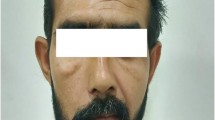Abstract
AIM : To describe the presentation and outcome of rhino-orbital-cerebral mucormycosis (ROCM) in adolescents with type 1 diabetes mellitus (T1 DM).Methods : the medical records of six patients of T1 DM with ROCM admitted between October 2001 to January 2004 were analysed.Results : the mean (± SD) age and duration of DM of these patients were 16.1 ±3.0 years and 26.3 ± 24.9 months respectively. Four patients had ROCM at presentation, while two developed it during their hospital stay when recovering from diabetic ketoacidosis. Proptosis (100%) and ptosis (100%) were the most common symptoms, and ophthalmoplegia (85%) and vision loss (85%) were the most common signs. Maxillary sinus (85%) was the commonest paranasal sinus to be involved. All patients received amphotericin B and had appropriate surgery except one. Four patients survived. Patients who had altered sensorium, facial necrosis, palatal perforation and cerebral involvement at presentation had poor outcome.Conclusion : High index of suspicion of ROCM in T1 DM and combined approach with amphotericin B and appropriate surgery is rewarding.
Similar content being viewed by others
References
Yohai RA, Bullock JD, Aziz AA, Markert RJ. Survival factors in rhino-orbital-cerebral mucormycosis: Major Review.Surv Ophthalmol 1994; 39: 3–22.
Ferry AP, Abedi S. Diagnosis and management of rhinoorbital cerebral mucormycosis (phycomycosis): a report of 16 personally observed cases.Ophthalmology 1983; 90: 1096–1104.
Parfrey AN. Improved diagnosis and prognosis of mucormycosis: A clinicopathological study of 33 cases.Medicine 1986; 65: 113–123.
West BC, Oberle AD, Chung KJK. Mucormycosis caused by Rhizopus microsporus var. microsporus: cellulitis in the leg of a diabetic patient cured by amputation:J Clin Microbiol 1995; 33: 3341–3344.
Kline HW. Mucormycosis in children: review of the literature and report of cases.Pediatr Infect Dis 1985; 4: 672–676.
Artis WM, Fountain JA, Delcher HK. A mechanism of susceptibility to mucormycosis in diabetic ketoacidosis: transferrin and iron availability.Diabetes 1982; 31: 109–114.
Marchevskey AM, Bottone EJ, Geller SA. the changing spectrum of disease etiology and diagnosis of mucormycosis.Human Pathology 1980; 11: 457.
Moye J, Rosenbloom AL, Silverstein J. Cinical predictors of mucormycosis in children with type 1 diabetes mellitus.J Pediatr Endocrinol Metab 2002; 15: 1001–4.
Smith JL, Stevens DA. Survival in cerebro-rhino-orbital zygomycosis and cavernous sinus thrombosis with combined therapy.South Med J 1986; 79: 501–504.
Abramson E, Wilson D, Arky RA. Rhinocerebral phycomycosis in association with diabetic ketoacidosis.Ann Intern Med 1984; 1060–1062.
Author information
Authors and Affiliations
Corresponding author
Rights and permissions
About this article
Cite this article
Bhadada, S., Bhansali, A., Reddy, K.S.S. et al. Rhino-orbital-cerebral mucormycosis in type 1 diabetes mellitus. Indian J Pediatr 72, 671–674 (2005). https://doi.org/10.1007/BF02724075
Issue Date:
DOI: https://doi.org/10.1007/BF02724075




